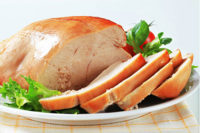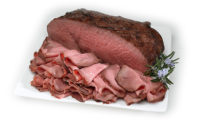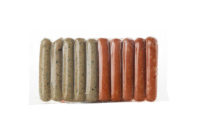The Ins and Outs of Post-Packaging Pasteurization
By Lisa White
Much can be done to make products safer after they are packaged.
With the Agriculture Department’s (USDA) zero-tolerance policy where food-borne illness is concerned, it was only a matter of time before the focus turned to post-packaging pasteurization (PPP) in the meat and poultry industry.
This is because the process is designed to control listeria contamination, in particular, after meat is processed and packaged, providing one more barrier for increased food safety.
"Contamination occurs after pasteurizing if small amounts of listeria make it into the packaging,” explains Jim Marsden, Regents Distinguished Professor of Meat Science at Manhattan, KS-based Kansas State University. “You may have a low detection at the time of packaging, but this pathogen will grow under refrigeration. Consequently, six to eight weeks later, this package can have hundreds of thousands of listeria pathogens.”
Bacteria is measured in logs, going up in multiples of 10. For example, 1 log is equal to 10 cells, 2 logs is equal to 100 cells, and 3 logs is equal to 1,000 cells, etc.
The USDA has developed three food plant classification levels for ready-to-eat (RTE) processors, depending on the level of listeria risk:
Alternative 3: Plants that rely on sanitation only, which are required to test and hold product prior to shipping
Alternative 2: Plants that use either a post-lethality step or an inhibitor
Alternative 1: Plants using both a post-lethality step and an inhibitor
The USDA’s initiative encourages the meat industry to have a post-process lethality treatment as a means of eliminating listeria on the surface of processed meats. This can be achieved before final processing, after processing, but before packaging or, in the case of PPP, post packaging.
PPP is achieved primarily using irradiation; liquid, such as with hot water systems; or through a high-pressure processing method.
Irradiation
When using irradiation, there are three ways to generate energy — gamma rays, electron beams, and x-rays. Each type varies in terms of the energy it takes and product penetration. While e-beams only penetrate 2 1/2 inches of the product’s surface, gamma rays and x-rays pass through several feet at a time. All three processes work by passing energy through food to break up the DNA of pathogens or spoilage organisms.
“X-ray irradiation is experimental because it is energy intense in terms of food,” says Rick Hunter, president and chief executive officer of Food Technology Service, a Mulberry, FL-based food irradiation center that uses gamma ray technology.
With this PPP process, gamma and other needed energy is stored in rods that were formerly used as control rods in nuclear power plants. “Energy cobalt sticks to the rods’ metal, but it is not strong enough to make anything radioactive. This is simply stored energy,” explains Hunter. “It is the energy the rods emit that makes food safer.”
The metal rods use half of their energy every 5 1/4 years, so they last 20 years or more. The effectiveness of this process is between 4-and 5-log rhythmic reductions. “If pathogens enter a hamburger after production, you may expect one-hundred organisms, such as E. coli. So instead of one-hundred, we have lowered the potential of pathogens to .01 with a four-log reduction,” explains Hunter. “What irradiation does is offer another barrier in a multiple-barrier approach to food safety to keep pathogens from entering the food supply.”
The modern unit of measurement for radiation energy absorbed in irradiation use is the Gray or Gy, which is equal to one joule per kilogram. This replaces older terms, such as the Rad or Radiation Absorbed Dose.
Omaha Steaks, based in Omaha, NE, has been irradiating its ground beef since the fall of 2000. “Our company president, Bruce Simon, decided to use this process after hearing news reports about children being affected by E. coli,” says Beth Weiss, Omaha Steaks’ public relations manager. “At the time, it wasn’t the most popular way to go, but he decided the benefits definitely outweighed the risks.”
The company’s ground beef is trucked to Food Technology Service’s Florida plant for irradiation and then sent back to its headquarters, which is a five-day trip. “The purpose of doing it is strictly the food-safety component. With irradiation, many potential harms are taken out of the product. It hasn’t affected our ground beef sales, so we know our customers must be accepting of this method,” says Weiss.
Another irradiation company, Gray Star, based in Mt. Arlington, NJ, offers modular irradiation units that feature a low start-up cost and provide easy installation. The Genesis Irradiator irradiates product at the bottom of a water pool via an overhead hoist and trolley system.
High-pressure process
One of the newer technologies for accomplishing PPP, high pressure, can be used with any type of meat or poultry product.
Avure Technologies, Kent, WA, provides high-pressure PPP equipment for use in plants. High pressure is a thermodynamic process based on the Le Chatelier principle, which states that actions that have a net-volume increase will be retarded and actions that have a net-volume decrease will be enhanced. In the workings of a living bacteria cell, pressure-sensitive processes are impacted by high pressure resulting in the inability of the bacteria to survive. These processes range from protein function and enzyme action to cellular membrane structure. Small macromolecules that are responsible for flavor, odor, and nutrition are typically not changed by pressure.
Avure’s vice president of research and development, Ed Ting, says that additional heat, irradiation, and chemical additives do not need to be used to destroy pathogens with high-pressure PPP processes. “Any time you slice meat, you run the risk of exposing it to listeria. Companies can take sliced product and run it through a heat bath, but you get a lot of purge with turkey, chicken, and roast beef. And thermal processes can cause heat damage,” he explains.
Although high-pressure PPP involves either the acquisition of high-pressure equipment or using a contractor for this service, Ting says it makes sense when looking at the benefits of this process. “Not only are you increasing food safety, but because spoilage material is destroyed along with the pathogens, the product has an extended shelf life,” he says.
Avure’s systems are currently being used by Hormel Foods Corp., Austin, MN, and Perdue Farms, Salisbury, MD.
Justin Segel, principal of American Pasteurization Co., a provider of high-pressure services in Wauwatosa, WI, and former owner of Emmpak Foods, says he was so impressed with this technology that he decided to set up his own operation. “No one was offering this service on a commercial basis,” he says.
He says the real value with this method is that it not only creates a safer product, but it also protects a company’s brand equity, as well as its customers. “There is so much value derived from the supply chain and marketing with this process,” says Segel. “People I see utilizing high pressure are doing it for reasons that go beyond pasteurizing. This process can double the shelf life of most RTE products to 125 days.”
Hot water
Although not technically a PPP method, Alkar-RapidPak, in Lodi, WI, provides hot-water pasteurizers for turkey breast, ham, and roast beef, among other products. Items are put into trays and loaded into a vertical serpentine system. The first zone contains a hot-water pasteurizer, which treats products for three to four minutes in 200° F water. This provides a 3-log kill, relays Bob Hanson, vice president of research and technology. “Products that contain nitrites tend to have higher kills, while products with rough surfaces, like roast beef, have a lower kill because the surface is less exposed. For this reason, treatment times vary. The longer the treatment, the higher the kills,” he explains.
The next step involves chilling the product in a separate system before the heat migrates to the product’s center. This cooling system takes between 20 and 60 minutes in a 24° F cold liquid consisting of salt water or a propylene glycol mixture to prevent freezing. Companies using this system include Sara Lee for its turkey breast and roast beef, in addition to the turkey lines from Jennie-O, Carolina Turkey, and Foster Farms. “Because turkey doesn’t contain nitrites, it is used often with this process,” says Hanson.
Although this system is compact, it is tall in height.
Alkar-RapidPak introduced a new process for hot dogs last October. Called Flash Pasteurization, the unit fits onto a packaging machine to surface pasteurize product before it is packaged using 200° F steam. “We have two units operating in the field right now,” says Hanson.
Des Moines, IA-based Townsend Engineering Co. offers a pasteurization service with a system for sausage that, although also not technically a PPP method, operates on a similar principal by deriving a lethal kill inside product packaging. Jos Kobussen, sales manager of the company’s QX Systems, says the process involves partially cooking sausage links to an internal temperature of 130° F to coagulate enough proteins to package the meat. The final cook with this system is done in hot water after packaging. “This method is an Alternative One treatment, offering a 10-log reduction,” he says, adding that he predicts eighty percent of all sausage making will eventually utilize this technology.
Because the product is not fully cooked before packaging, Townsend’s method is not considered a PPP process. “We propose you only cook products enough to be packaged and finish cooking inside the package. This creates no problems with purge and other quality issues,” says Kobussen. Sausage makers such as Sara Lee and ConAgra use this system, he adds.
Like pressure treatments, Bristow, OK-based Unitherm Food Systems offers a pre-pasteurizing unit that has a high lethality rate and offers shelf life improvements of up to 90 percent, says David Howard, president.
The infrared pre-pasteurizer fits in front of vacuum-packaging machines, exposing meat surfaces to temperatures of 1,200° F for one minute. This provides a 3.5-log listeria reduction. The meat is then packaged and placed in a water pasteurizer for five seconds to neutralize the temperature. “After infrared treatments, there is a five-second window where the product could become contaminated, so we place it in the water to eliminate this exposure,” says Howard.
Although installation of the infrared system is simple and inexpensive, water pasteurizers are more difficult to incorporate in meat plants due to their larger footprints.
One of Unitherm’s clients, Stevison Ham Co., based in Portland, TN, was one of the first companies in the country to install an infrared pasteurization system. Mike Stevison, president, says: “A study we commissioned at Oklahoma State University proved this system to be the cutting-edge technology in controlling pathogens. The heat source touches every nook and cranny, so there’s nothing between the heat source and the products’ surface. It is a tremendous step forward in terms of food safety.”
Intervent, the new food-safety technology and consulting arm of BOC, based in Murray Hill, NJ, offers ozone and ultraviolet light technologies specifically designed for use in meat plants. Mark DiMaggio, business manager, relays that this process is not a pasteurization process, rather a validated USDA/Food Safety and Inspection Service (FSIS) acknowledged listeria post-lethality step with demonstrated reductions of at least 2 logs on read-to-eat (RTE) products being the norm. “The foundation of the technology is aqueous ozone created on-site through the use of a generator. This on-site generation precludes the continual replenishing of chemicals and is, thus, substantially less expensive for food plants to employ. Since there is no additional heat, radiation, pressure, or other form of energy to the product, there are no organoleptic changes to the product and no change in flavor. Since ozone is able to demonstrate reductions in excess of two logs, it is categorized as an enhanced post-lethality intervention,” he says.
BOC Intervent's ozone technologies do not require a significant capital investment or have high operational costs. Also, the system is affordable to install and takes up minimal space in processing plants, says DiMaggio.
SteamLab Systems, located in Hamburg, Germany, specializes in natural pasteurization or sterilization of dry products. The concept is based on a combination of temperature and kinetic forces. “This is realized by a very deep-vacuum, high-quality saturated steam, and high-tech control of the process,” says Gerard Markerink, who heads the company’s marketing and sales. “Meat processing plants use a lot of dry ingredients, which can be contaminated, and many U.S. companies sterilize these ingredients to kill coliforms.”
With this system, the dry products being treated are placed in a stainless-steel chamber, where a deep vacuum brings steam in at between 175° and 195° F. The color, taste, oil content, and bioactivity of the products remain unchanged. “We can get total plate counts of lower than 1,000 cfu/g,” says Markerink. NP
Lisa White is a freelance writer based in Illinois.
Technology providers participating in this report include:
Alkar, (608) 592-3211, www.alkar.com
American Pasteurization Co., (414) 332-4400, www.pressurefresh.com, justin_segel@segelland.com
Avure Technologies, (800) 610-1798, www.freshunderpressure.com, webmaster@avure.com
BOC Intervent, (908) 464-8100, www.boc.com, randy.cable@boc.com
Food Technology Service, (863) 425-0039, www.foodtechservice.com, rhunter@foodtechservice.com
Townsend Engineering, (515) 265-8181, www.townsendeng.com, info@teconet.com
Unitherm Food Systems, (918) 367-0200, www.unithermfoodsystems.com, unitherm@unithermfoodsystems.com




Report Abusive Comment